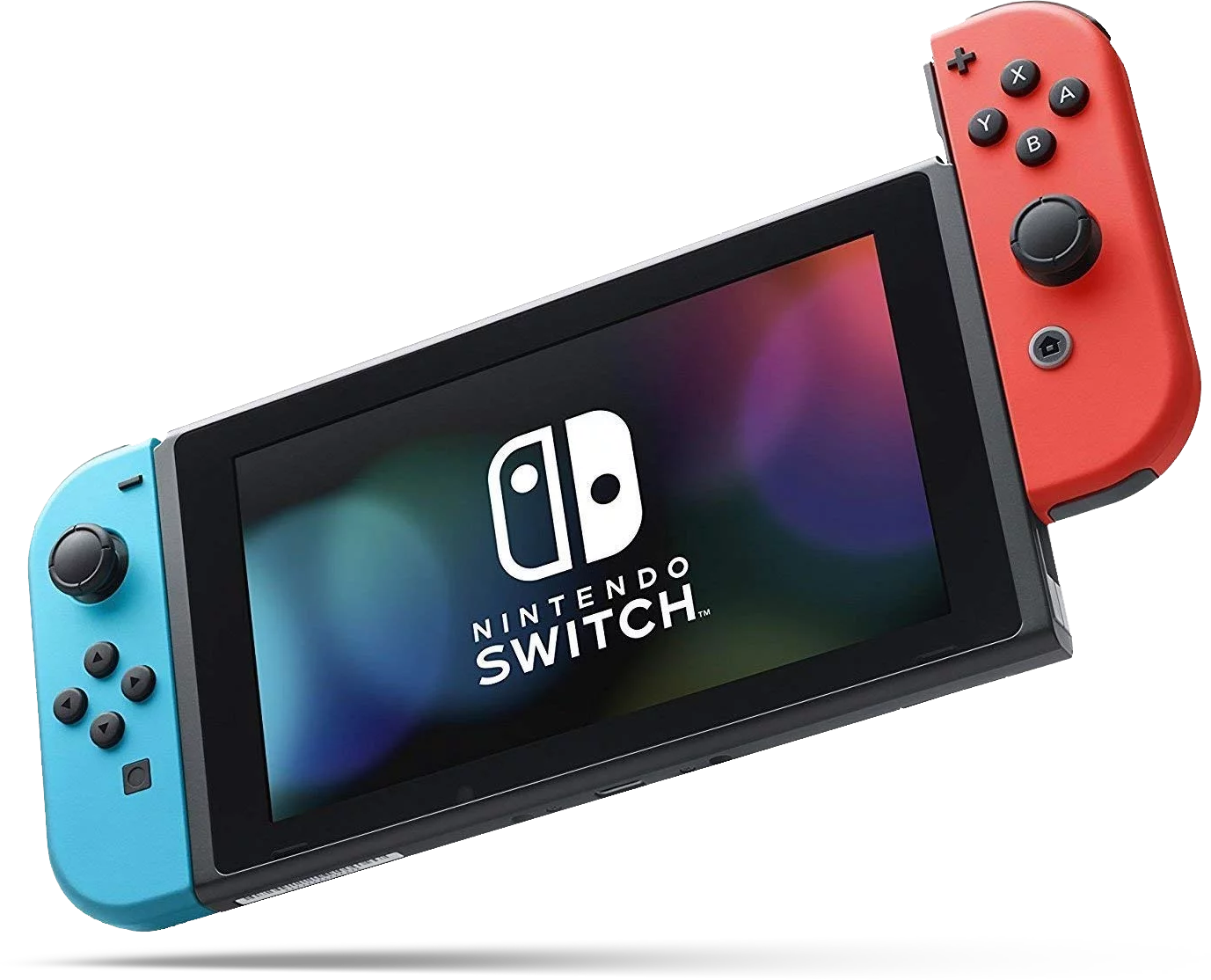Monster Hunter Generations Ultimate for Nintendo Switch: Tips and Tricks!


You've probably heard of a little action RPG game called Monster Hunter lately. That's because this year, they released Monster Hunter World on home consoles and PC, but they've also brought Monster Hunter Generations Ultimate to the Nintendo Switch after its initial release in Japan a year ago.
Monster Hunter is a game where players literally hunt large monsters (it's part of the ecology) and use parts from those monsters to craft armor and weapons to better prepare for the next hunt. You repeat this process over and over — it's a bit grindy, but worth the efforts to look like a badass.
While Monster Hunter's a great franchise, it's definitely overwhelming if you've never played before, or are still relatively new to the game. This is especially true for Generations Ultimate, as it introduces some new changes from previous Monster Hunter handheld titles. That's why we've rounded up some tips and tricks to help you get the most out of your time with Monster Hunter Generations Ultimate (MHGU).
- Questing fundamentals
- Always remember to eat
- Try out every weapon
- Experiment with Hunting Styles and Arts
- Gather everything
- Make item and equipment sets
- Understand skill points on gear
- Proper Hunter's Hub etiquette
Questing fundamentals
Everything that you do in Monster Hunter's done through quests. In each game, there's usually a girl around the middle of the village who handles quests. Quests may have a variety of different objectives, such as making deliveries, killing or capturing specific monster(s), or even making incredibly large and tough beasts retreat, saving villages from impending doom.
The one thing all newbies must understand before starting quests in Monster Hunter is the fact that the game does start a bit slow. The first couple of missions available are deliveries or something like killing 10 small monsters as the objective. These are a bit boring, but necessary to understand the fundamentals of the game before you tackle the larger beasts.
Choose where to take on quests from
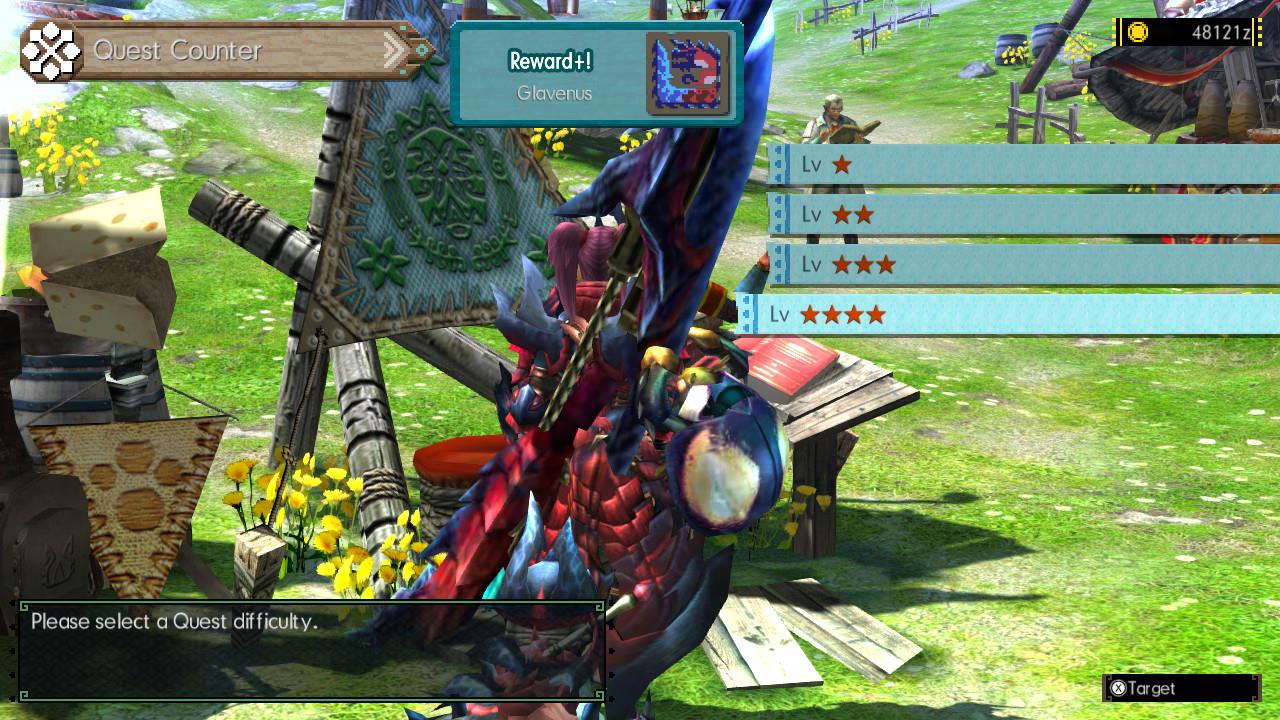
There are two areas to complete quests in MHGU: Village and Hunter's Hub. Village quests are strictly single-player, advance the story, and unlock key parts of the villages that make your hunting life easier. Hunter's Hub allows for four hunters to hunt together and raise their Hunter Rank. Think of Hunter Rank like character level, since it gets unlocked after you hit G-Rank and the number increases as you earn HR points from hunts.
iMore offers spot-on advice and guidance from our team of experts, with decades of Apple device experience to lean on. Learn more with iMore!
Village Low Rank quests go up to 5 stars, High Rank starts at 6, and G-Rank quests are the 10 Advanced missions that aren't for the faint-of-heart.
In Hunter's Hub, Low Rank is 1-3, High Rank is 4-7, and G-Rank is G1-4.
While you're free to do every quest that's available in each level, there are technically only certain ones that you need to complete in order to progress to the next set of quests. These are called Key Quests, and you can find a list of Village Key Quests and Hunter's Hub Key Quests on the MHGU Wiki. However, other non-key quests can unlock important things in the village, and even add more ingredients to your canteen's menu.
MHGU also makes things interesting with a new Hunt of the Day, which you can complete to earn extra rewards and zenny (currency).
Know the conditions of failure and success
In every quest, hunters get 50 minutes to complete the objective, unless otherwise stated. Once the objective's met, such as killing or capturing a monster, then it's complete and you return to the village in 60 seconds.
You'll fail the quest if you don't finish in time, or if you faint (lose all health) three times unless a mission says otherwise. That's why it's imperative to know your enemy and dodge their moves at the correct time! Less hits taken means less chance of failure.
Take advantage of the Supply Box
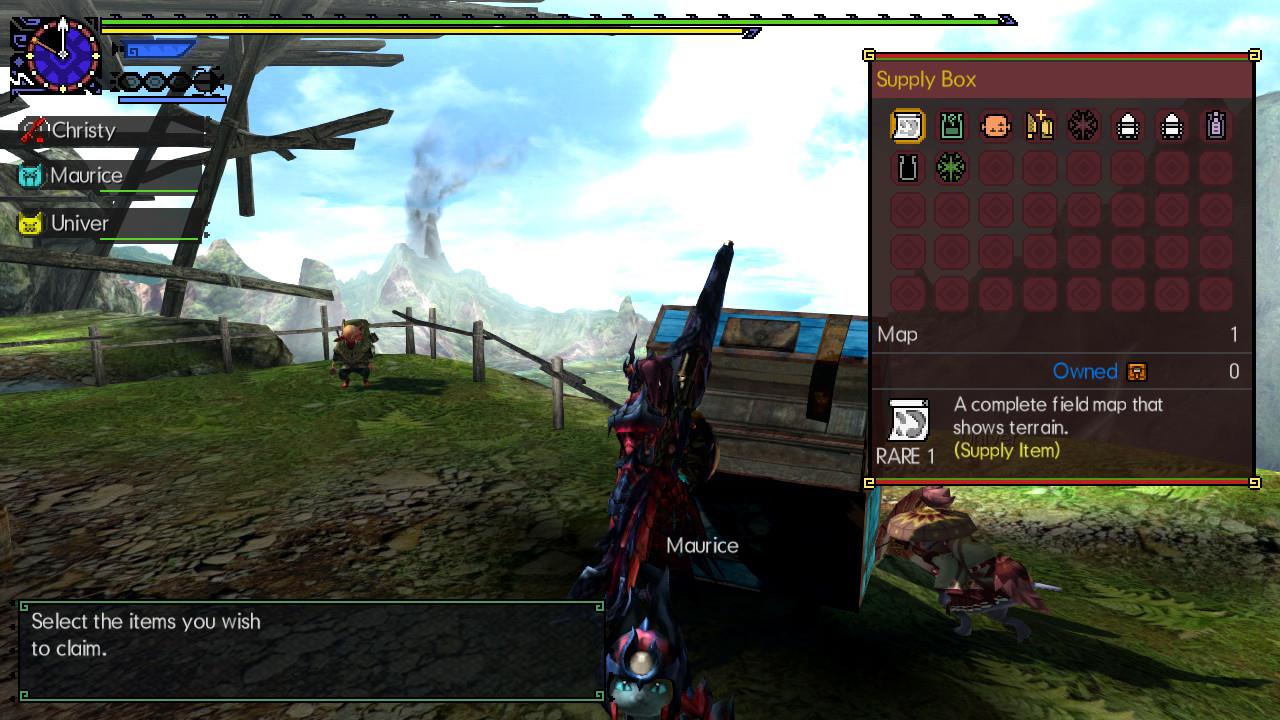
When you're in Low Rank, you start out at the beginning of each area, where there's a camp set up. A blue chest holds some useful freebies that you can grab for the hunt. If you don't use them, they get returned at the end of the quest.
In High and G-Rank, hunters get dropped off in random zones on the map. To make things more difficult, the supplies in the blue supply box get dropped off after a few minutes of the quest starting. So if you're in the higher level quests, you'll need to be patient and tough it out if you still want these freebies.
You may also notice a red chest at camp. This is where you drop off items for delivery, such as wyvern or herbivore eggs, and unique account items that net you more guild points.
Always remember to eat
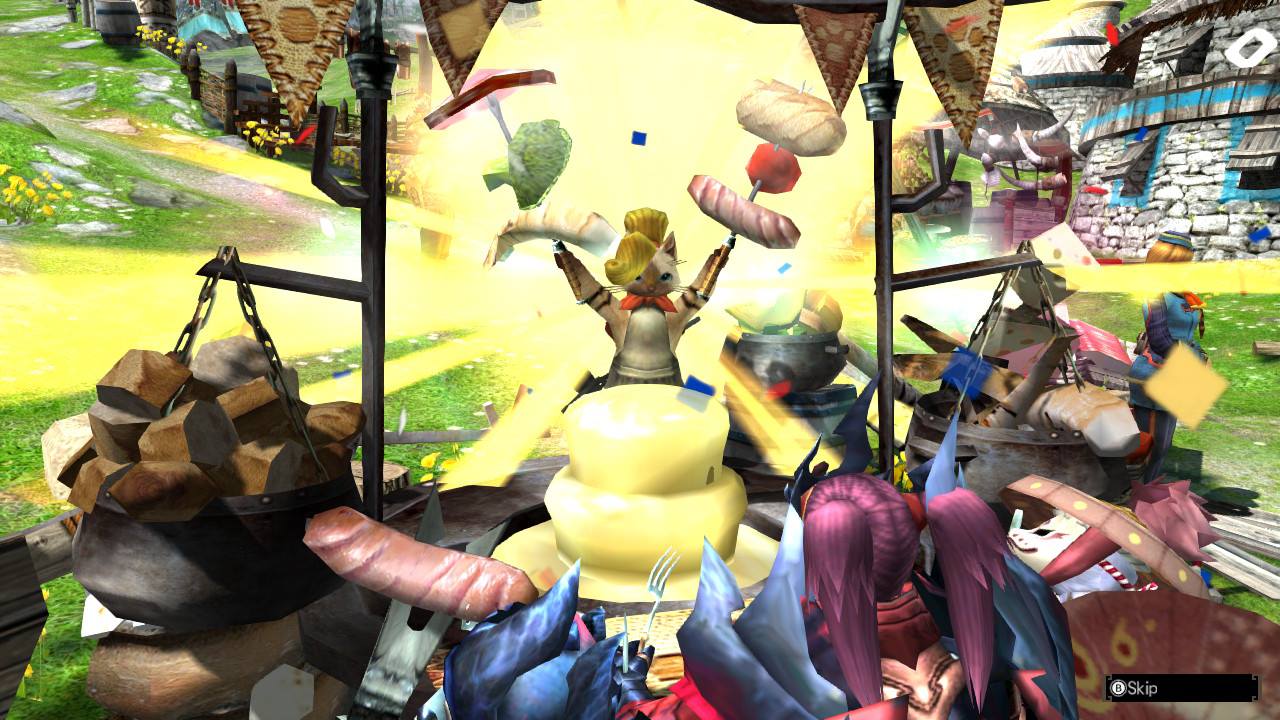
Before setting off on your quest, always make sure you hit up the canteen for a hearty meal.
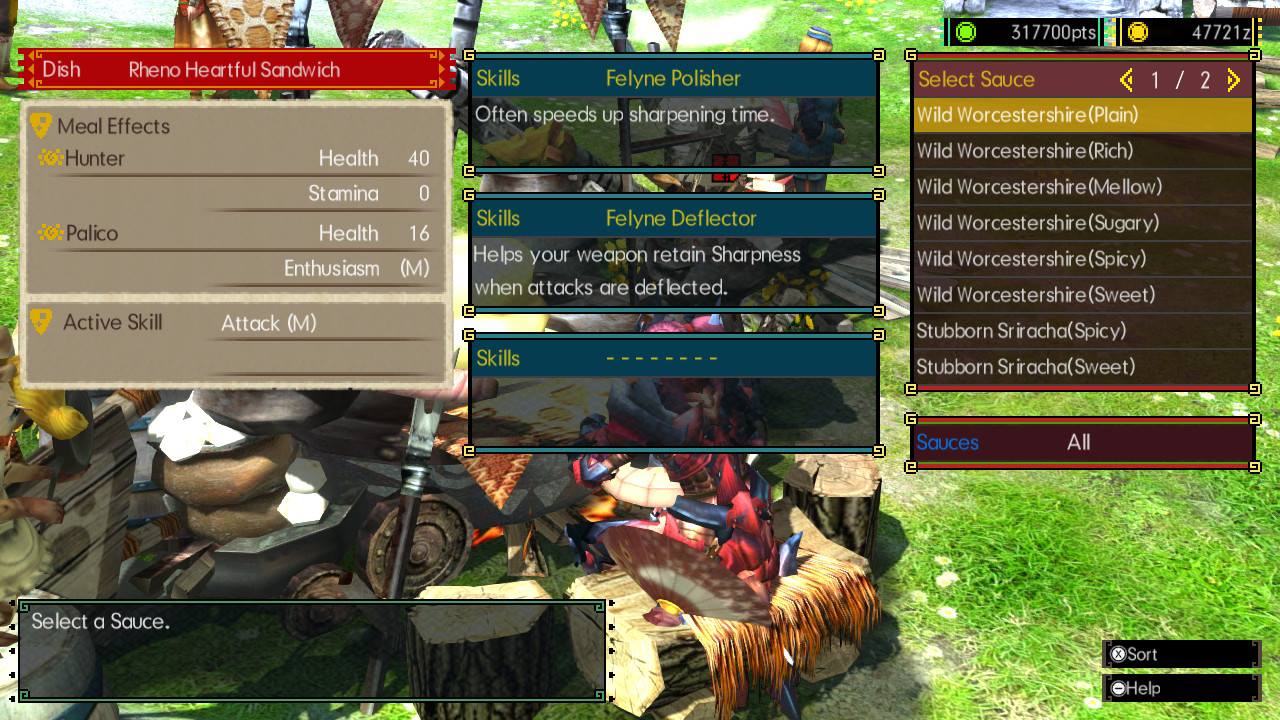
Why is eating so important? It's simple, you don't want to go out on a hunt with base stamina and health, right? Eating meals boosts your existing HP and Stamina bars so you can take more hits, or do more evasive maneuvers. Plus, some weapons have modes that deplete your stamina, such as Dual Blades' Archdemon mode, so you want to have as much as possible.
Meals in Monster Hunter also provide beneficial passive abilities that come in handy, such as Polisher that lets you sharpen your weapon faster, or Carver, where you can gain extra carves from a monster corpse. You may also get improvements to your defense and attack strength, which is always helpful.
Try out every weapon
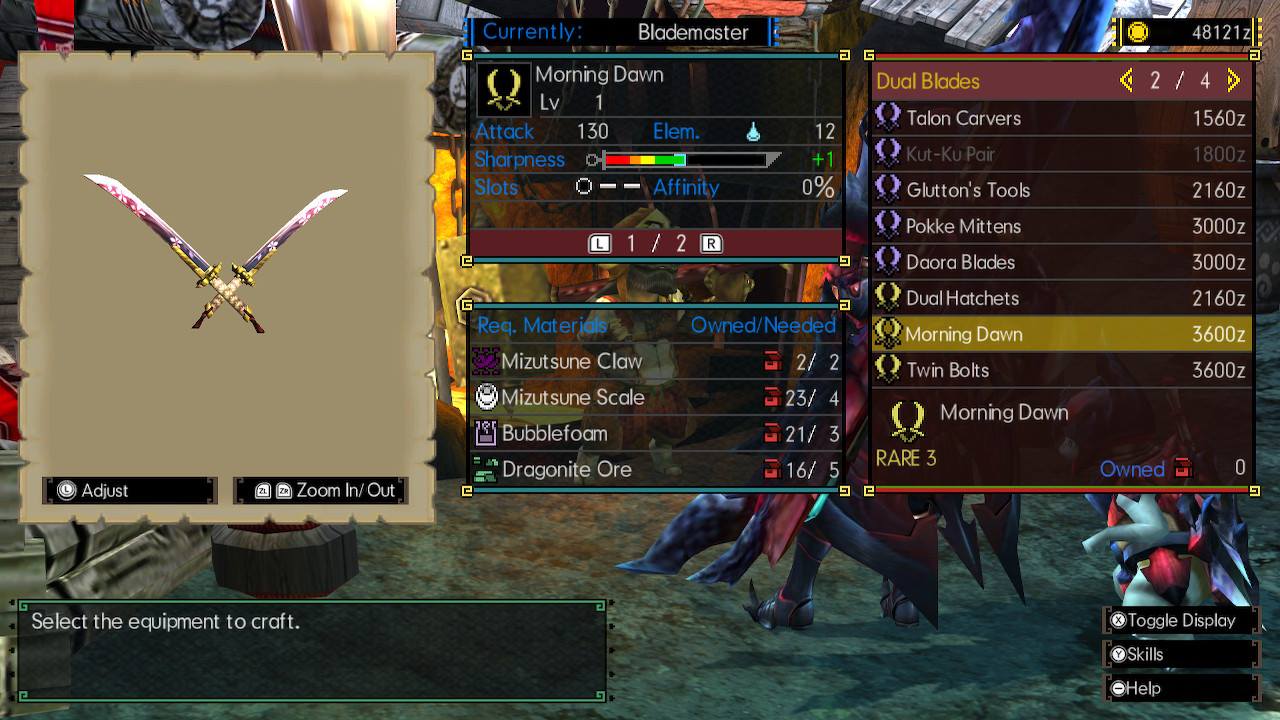
The one thing that I often hear about newbies coming into Monster Hunter games is the fact that they don't like how "slow" some weapons are, or how weapons must be sheathed to use items and whatnot. This does take some getting used to since Monster Hunter is not your typical hack-n-slash game. You must put thought into how you move, just as you would if you were actually hunting.
There are 14 different weapon types in MHGU:
- Greatsword
- Sword and Shield
- Longsword
- Dual Blades
- Lance
- Gunlance
- Switch Axe
- Hammer
- Hunting Horn
- Insect Glaive
- Charge Blade
- Bow
- Heavy Bowgun
- Light Bowgun
Every weapon type plays differently. Greatswords tend to make you move slow and require good timing to land hits, but deal heavy damage with each hit. Dual Blades are super fast and easy to chain into combos, but each individual hits don't do much damage on their own. Sword and Shield is the only weapon type that lets hunters use items while the weapon's unsheathed, and has fairly quick attacks like Dual Blades. Insect Glaive is a staff-like weapon that also has a "kinsect" aspect, which is used to gather extracts from monsters to boost your own abilities.
If you prefer ranged, there's the Bows and Bowguns. Bows use arrows, while Bowguns require a different ammo that you must craft. Light Bowguns deal more in elemental and status damage and are more mobile, whereas Heavy Bowguns focus on raw damage and explosives.
There are a lot of options to choose from in Monster Hunter, and I recommend going into the training quest for each weapon type to find what you like using. For newcomers, Sword and Shield is always a good starting point —or even Dual Blades. If you don't mind slow movement using heavy hits, then Greatsword is a classic.
Experiment with Hunting Styles and Arts

A new addition in Generations were Hunting Styles, and this carries over into the Ultimate edition as well. There are six styles to learn: Guide, Striker, Aerial, Adept, Valor, and Alchemy.
Guild's the traditional style that you may be used to from older games. You get two slots for Hunter Arts. This is the best way to learn the game if you're a beginner.
Striker's another style that's good for beginners. You get three Arts to equip, and you build up your Arts by getting hit in addition to landing successful hits. However, you lose some fine distinctions for certain weapons in this style, such as Dual Blades' Archdemon mode.
Aerial allows players to hop around areas due to their movement. When you dodge with the B button, your hunter jumps. This turns into a large leap if you hit a monster in the air, or even hit another hunter or bomb. However, you only get one Art to equip with this style.
Adept is the hardest of them all and focuses heavily on countering your enemies. This one isn't for beginners, but veterans who know how to read the monster's movements and counter at the correct time. You also get only one Art with Adept style.
Valor relies on sheathing to fill up your gauge and enter the Valor State, which means you hit harder and move faster. This style involves canceling attacks by sheathing to fill up your Art gauges and avoid incoming attacks with a sheathing stance.
Alchemy is the support style. It allows for three Hunter Arts, and you can use Alchemy Barrels to create Alchemy Items, power up your SP State and Hunter Arts, and more.
Each style can completely change how a weapon plays, so there's a lot of experimenting involved with figuring out your own play style. Valor and Alchemy are new to Generations Ultimate, as they were not in the original base game.
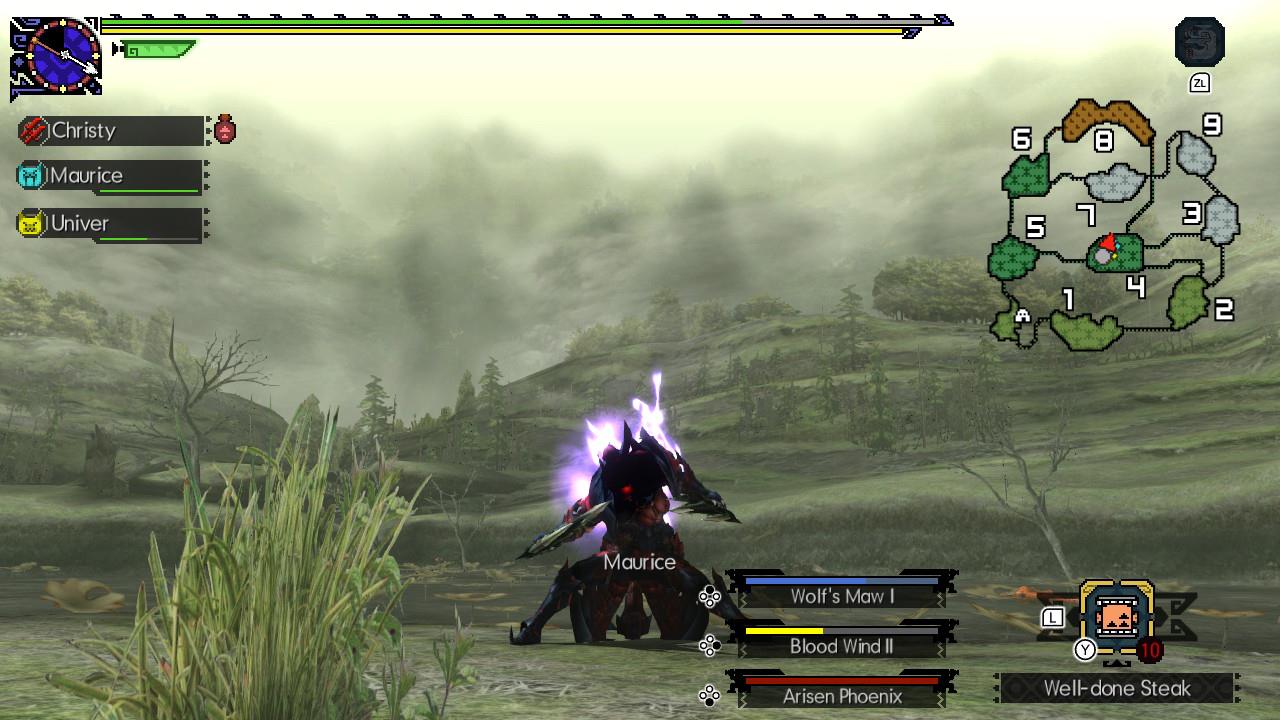
Arts get unlocked as you progress through the story, and these are powerful moves you can perform once the gauge is full. Hunter Arts can be devasting attacks for specific weapons, general evasion or defensive maneuvers, and even counters to attacks.
Styles and Arts make up the meat of the game in terms of gameplay, so try out as many as you can! You'll definitely find something that you'll end up loving.
Gather everything

I know — you want to go out and take on the big monsters to get amazing gear. But that process takes time! You need to gather resources first to make items that help you survive out in the wilderness.
An important aspect of Monster Hunter is gathering. While you're out exploring the land, look for anything interesting on the ground or on walls. If something sparkles, that means you can gather it. Just walk over to it and press the A button until there's nothing more you can pick up.
Some gathering points require special tools. You'll need pickaxes to mine ore, and bug nets to catch insects. You'll also want to gather up honey as often as possible, as it's used in a lot of crafting recipes, specifically the important healing items.
If there's anything I learned from pouring hundreds of hours into several Monster Hunter games, it's the fact that you should pretty much pick up and gather everything.
Eventually, you'll unlock a small farming section in the village, where you can duplicate common resources.
Make item and equipment sets

In every Monster Hunter game, you'll end up going through a variety of different quests that take place in cold or even scorching environments, or you just need to relax and go out gathering resources for later hunts. You'll also do a lot of farming of monsters for parts, and every beast has their own set of weaknesses for you to exploit.
An essential tip that makes your hunting life easier is to create both item and equipment sets.
Item sets would be what you carry along in your pouch for each quest. This should always have Potions, Mega Potions, Honey (mix with Potions to create Mega Potions), Nulberries, Paintballs, Antidotes — you know, the essentials. However, you'll end up in hot or cold areas, which require cool or hot drinks respectively.
You can save item sets in your item box (located in your room or next to the departure gate), and when you are preparing to go out on a hunt, just select the item set you want, and swap it out with what you're carrying. Those items you just swapped out get stored in the item box, and you're good to go! It's also a great way to top off the necessities.
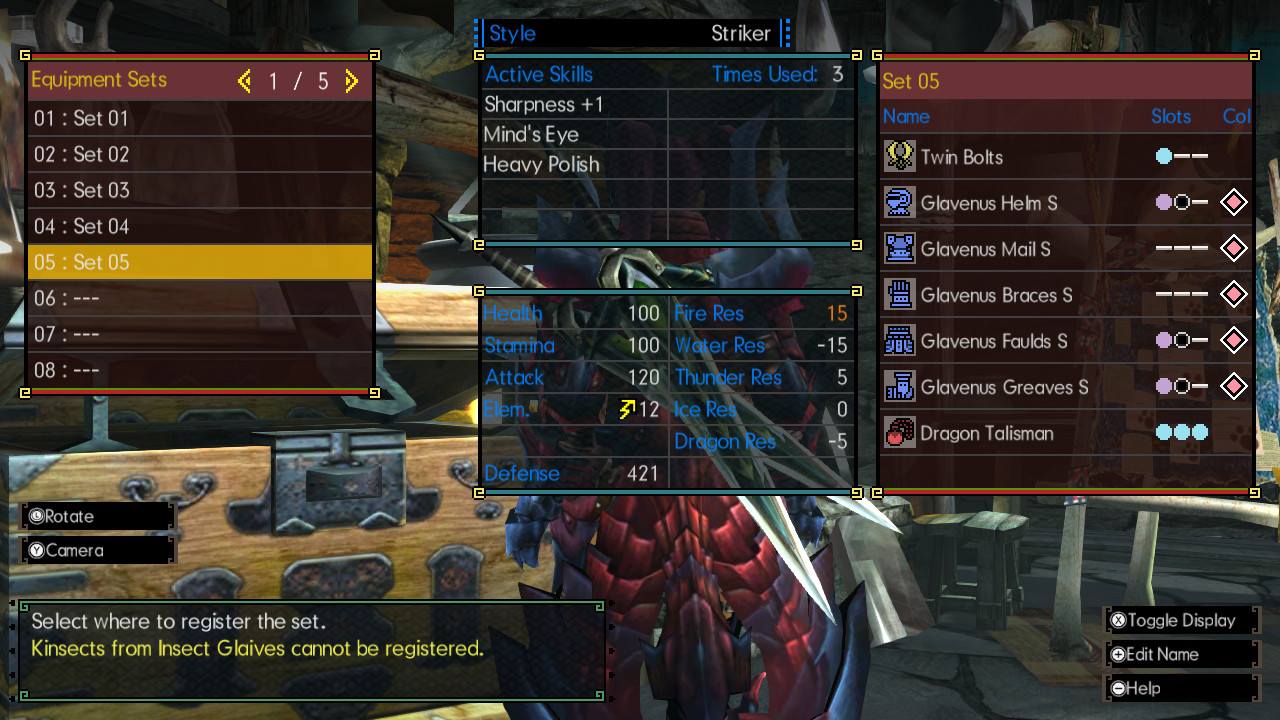
The same can be done for your equipment. Perhaps you like a certain armor set because of its skills, and prefer it with a certain weapon. Save it as an equipment set, and then change out your gear when you need it! As you build up a collection of armors and weapons, you'll be doing a lot of swapping out based on what monster you're hunting or even gathering runs.
Understand skill points on gear
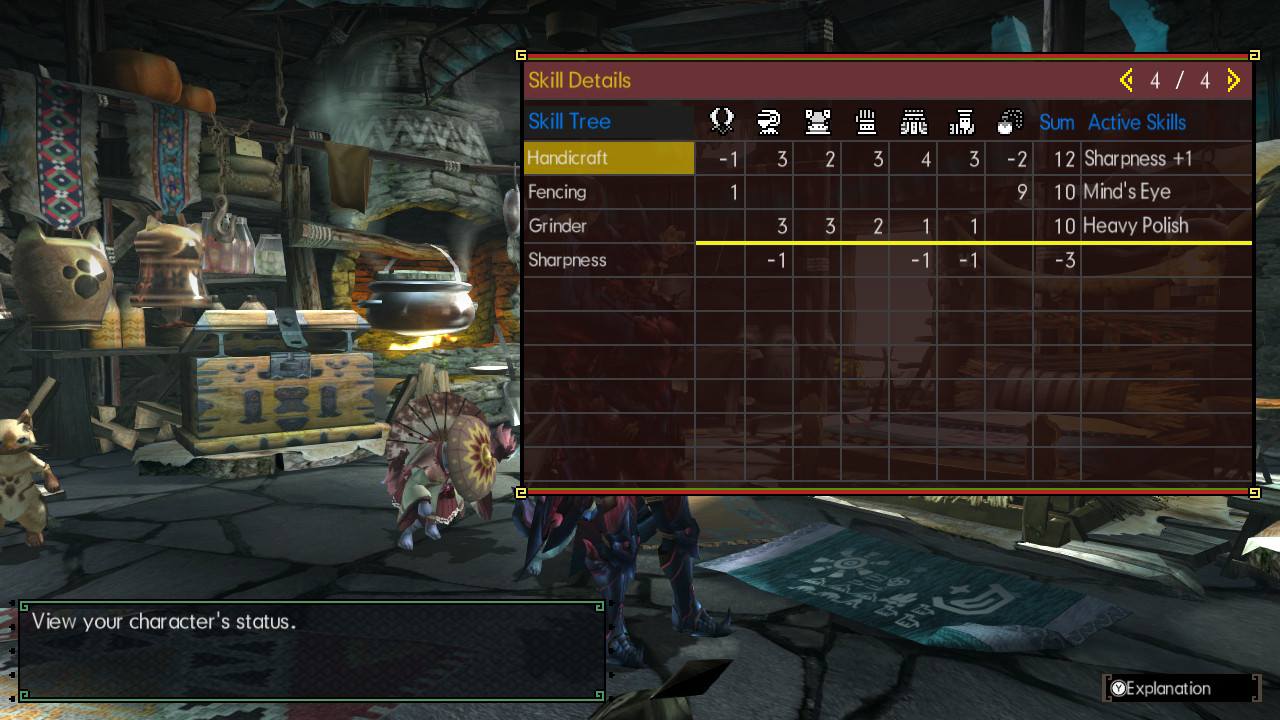
When you craft armor, you'll see that each piece has a point value in a skill. But don't think that equipping this single piece of armor means you get that skill. That's not how that works at all, and it's a bit confusing for newcomers (this is all solved in Monster Hunter World, where each piece of armor has its own active armor skill).
In the standard Monster Hunter games, hunters need at least 10 points in a skill for it to be active. Anything below that means that the skill is dormant. Some skills can reach up to 15 points for maximum effect. Older games also had negative skills that needed to be gemmed out (equip a gem with a skill that counters the negative skill), but this was removed in Generations.
To create the perfect armor set with the best skills and looks cool is a task in itself. I'd recommend going for complete armor sets (one monster's set) first before venturing out and trying to create mixed sets for skills.
Proper Hunter's Hub etiquette
While it's a ton of fun to hunt with others through either local or online multiplayer, there's definitely some issues with randoms joining you or even playing with friends who don't know proper etiquette.
Always support each other
When you're in multiplayer quests, it's usually scaled for the number of people that are in the group. Meaning that if you're hunting with anyone besides yourself, it's going to be more difficult than a solo hunt.
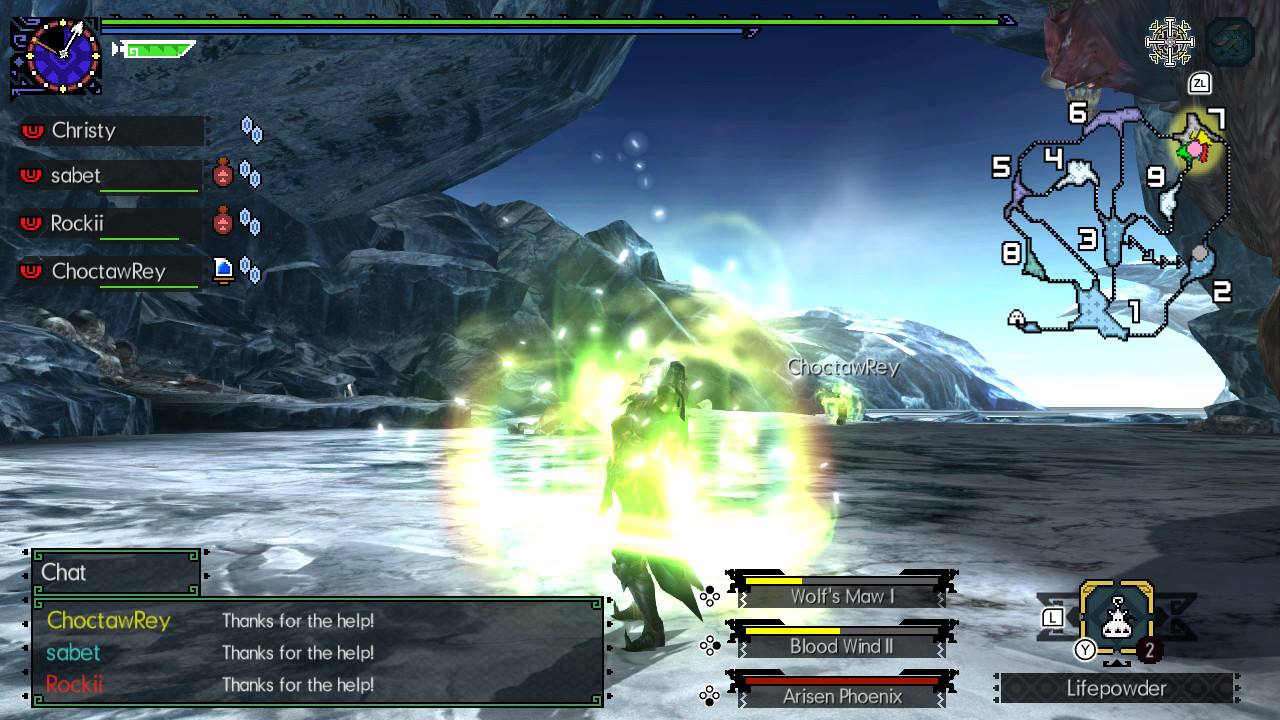
Monsters have more health and hit harder, but you still fail if your team winds up with three "carts" (when you faint, Palicos wheel you back to camp in a wooden cart) or run out of time. That's why you should always try to keep an eye on your teammates' health bars, and always pop a Lifepowder when necessary.
I speak from experience — I've had numerous hunts in the past where the quest was a failure because someone didn't feel the need to use Lifepowder on a teammate who was near death. Guess what? That player tried to heal themselves but got hit (monsters tend to target those who are trying to heal), and everyone failed.
There are other ways to be more of a team player as well. Watch what your teammates are doing, such as setting up a trap to capture a sleeping monster, instead of waking it up with a weak attack. Or if the team is setting up bombs around a sleeping monster, let the hunter with the strongest attack set off the bombs, since sleeping beasts take triple damage. Oh, and don't hog up all of those Max and Ancient Potions in the Supply Box for yourself — sharing is caring.
It's imperative to cooperate with each other and help one another out when hunting! After all, you're in it together! Communication's key.
Happy hunting!
Monster Hunter Generations Ultimate is one of those games that's packed to the brim with things to do and collect. Again, while it starts off slow, things do pick up once you get a good set of gear, and you'll become hooked to the thrill of the hunt.
There's a lot to this game, but these tips and tricks should help you get going for a great hunting experience.

Christine Romero-Chan was formerly a Senior Editor for iMore. She has been writing about technology, specifically Apple, for over a decade at a variety of websites. She is currently part of the Digital Trends team, and has been using Apple’s smartphone since the original iPhone back in 2007. While her main speciality is the iPhone, she also covers Apple Watch, iPad, and Mac when needed.
When she isn’t writing about Apple, Christine can often be found at Disneyland in Anaheim, California, as she is a passholder and obsessed with all things Disney, especially Star Wars. Christine also enjoys coffee, food, photography, mechanical keyboards, and spending as much time with her new daughter as possible.
